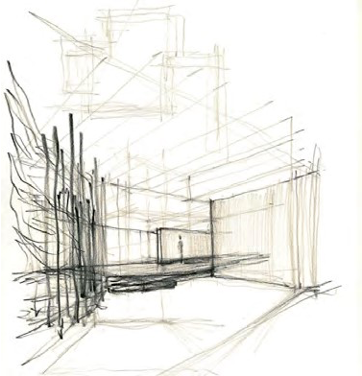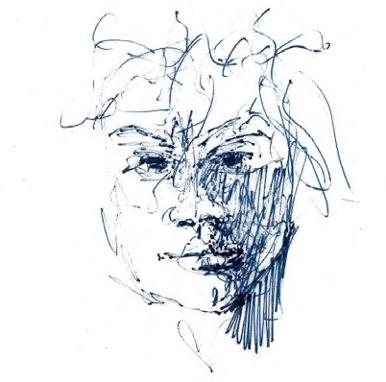Bill Tripp
William C Tripp, Architect, AIA
Adjunct Professor
University of Oregon, Portland Campus bill@tripparch.com
Summary Statement
In this workshop we will make a huge drawing, covering an entire wall. This drawing will emerge from our imagination, both individually and collectively. Drawing at such a large scale allows us to access stored experience, the muscle memory, of our whole body, not just of our hands and minds. While working individually, this will be a truly collaborative experience. Individual marks and gestures are related to, and sometimes overlay, previous marks, and might themselves be eventually covered. The work evolves through the discovery of shared experience, spatial concepts, and gestures. We work with great intention without being at all precious.
Topic
Drawing is the essential method of understanding for architects; it is our language. Architects must be able to draw freely and without fear, drawing to see, to understand, to imagine, to design and to communicate, all points on a continuum. Yet most architects are afraid to draw.
The purpose of architecture after all, is to create space which embodies human experience. The space, and often the experiences themselves, originate in the imagination of the architect. The most direct link between our imagination and the articulation of space is through the body, through the eyes, and through the hand.
Drawing as a daily practice connects us to the realm of our intuition. Through drawing we come to know the landscape of our imagination. We learn its features, and how to navigate freely among them. Drawing can be a casual affair, done on cocktail napkins, or it can be done while in a deep meditative state of mind. Either way, drawing is essential; it is our breath.
Scope
Fear of Drawing – Almost all students and architects are afraid to draw. They worry about the finished drawing being good enough; they worry about getting it right; or they don’t know what to draw. There is an almost universal hidden assumption that drawings document something already known, be it a schematic design, analytical principle, or construction detail. But in most cases the opposite is true. Drawing is an act of exploration and discovery. The most powerful drawings are the footprint of this process.
It is useful to ask ourselves why we don’t draw as freely as we speak. When we talk we aren’t expecting to say something so important that others will want to write it down. Why then do we expect every drawing to be worthy of keeping?
When we think of how children learn to talk we realize that they talk all the time; they begin with gibberish; they imitate what they hear; they make stuff up; and they see what works.
Translating that process to drawing means that we should draw every day; scribble a lot; draw stuff we see; draw stuff we like; draw from our imagination; and see what works.
To compound the problem, a state of anxiety inhibits the ability to draw, so freedom from fear and anxiety while drawing is crucial. The key to success in drawing is to make a lot of drawings! Quantity is really the most important factor in success, akin to practicing music or an athletic skill.
Drawing from Imagination – Drawing from one’s imagination is the easiest way to overcome fear and to achieve complete freedom in drawing so that you can draw every day. Scribbling is vastly under-rated. It is a form of play that allows us to draw without purpose. Far from being a waste of time, it puts us in touch with our intuition and imagination.
Drawing imaginary faces is easy since they are made up and you don’t have to struggle with getting the features right. This is key to eliminating anxiety of course, but it also teaches you how to draw actual faces. When you make random marks until a face emerges, the features are imaginary but the emotions expressed on that face are real. Connections are forged between mark-making and facial features and emotional expression. You build up a “library” that you can draw upon when drawing “real” faces from life or from a photograph.
The same is true with drawing space. Practice making random marks, following where your hand leads you, until you “recognize” some kind of space emerging. The particulars are imaginary but the spatial experience is real. This process forges connections between mark-making and spatial qualities. You are building up a vast spatial library that you can draw upon any time in the future. Every space you conceive of goes into the library. When designing a new project you can draw upon that vast resource of spatial types. You will be covering familiar ground.
Drawing in this way you will also discover your “default settings”, the schematic and spatial types you return to again and again. For each design you will be able to recognize if the scheme is unique to that project or just your default scheme.
By keeping a daily sketchbook and visiting compelling spaces you begin to understand the relationship between the spaces you document in your sketchbook and the spaces you imagine.
The link between spatial experience and spatial imagination is forged through your hand.
A Daily Practice – It is important for each of us to have a daily drawing practice to continue to learn and grow. I have changed my practice many times in the past. The latest change began a couple of years ago when I decided to post a drawing a day on Instagram. It wasn’t long before I realized that my archive only had so many drawings and I would have to come up with a way of actually making a drawing a day. I hit on a solution: I would draw on cocktail napkins, for all the obvious reasons, and because it is easy, fun and the drawings aren’t at all precious. It’s both practice and play, it helps me overcome my fear of drawing, and it exercises my imagination.
But also I also discovered that drawing with a pen on a napkin is a one-way ticket (there’s no erasing) so I have to commit to each and every mark. If I mess up the drawing, I can just throw it out and start over. This combination of decisiveness and ease has led to significant improvement in my mark-making. It doesn’t really matter how you manage it, whether it is playful and casual or whether it is deep and meditative, a daily drawing practice is essential.
Case Study/Workshop Activity
The workshop is a group drawing exercise during which 10 to 15 (or more) people contribute to a large drawing covering an entire wall. In this drawing we will create a large scale space, part landscape and part architecture, add openings or portals, and occupy the space with figures all while pursuing a transcendent spatial quality.
Photo backdrop paper (9 feet tall and 36 feet long) is attached to a wall and participants draw using charcoal, sidewalk chalk, conte crayon, graphite sticks and perhaps paint. Chairs, step stools or a step ladder or two are used to utilize the entire surface. Music is used to help shed rational intention and connect to intuition and imagination.
After a very short introduction and drawing warm-up, I begin by making marks to create an overall spatial structure. For example I might draw a horizon, distant hills, rolling terrain, a line of poles or a fence flowing across the landscape into the distance. Individuals engage with the drawing as the mood strikes them, waiting for an opening. They draw as long as the mark making impulse is fresh. I will change the music or make other mid-course corrections as needed. The emphasis is on responding to the drawing as a “space” and adding to it only when and where that space can be made stronger, richer, or more transcendent.
Intended Conclusions
By drawing in a group setting on a huge surface one discovers the content not only of one’s own imagination, but that of the entire group. This shared consciousness will produce a wonderful drawing, but more importantly perhaps, help forge a strong and cohesive community bond.
References
Juhani Pallasmaa. The Thinking Hand, (Chichester, UK: John Wiley & Sons, 2009)
David Ross Scheer. The Death of Drawing, (New York, NY: Routledge, 2014)
Sample Drawings (by author)


Imagined Space Early Spatial Concept – Residence


Imagined Face Manon Flokstra



